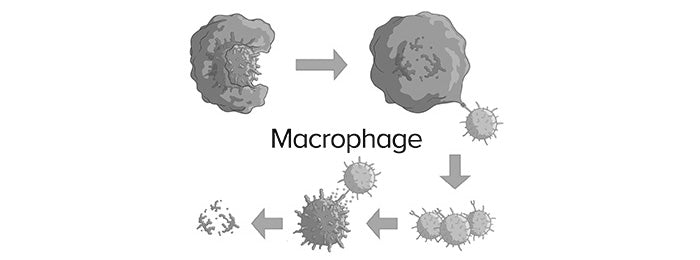Our body's immune system is a natural defense mechanism essential to survival. With such a significant role in health, the immune system is a common target of influence for integrative practitioners. However, many clinicians lose perspective of this important system with all of the nomenclature unique to this system. What follows is a clinician-oriented overview of natural killer (NK) cells and macrophages, two important components of the immune system.
This group of cells is divided into many families based on their structures, like interferons (IFN), interleukins (IL), tumor necrosis factor (TNF), transformation growth factor (TGF), and chemokines. The two most common producers of cytokines are macrophages and helper T cells (Th cells) and they influence both innate immune response and adaptive immune response.
Innate and Adaptive Immune Response
The body's first line of defense is the innate immune response. This response includes physical and chemical barriers to infection and responses that fight to stop the infection right when it starts.1 The innate immune response is prepared to stop many infections, but when it fails, the adaptive immune response begins. Unlike the innate immune system, the adaptive immune system is developed as a response to exposures to pathogens. Innate and adaptive immune systems have similar mechanisms to remove pathogens from the body, but the adaptive immune responses has the unique ability to recognize pathogens and distinguish one microorganisms from another.1 Macrophages and NK cells play an important role in the innate and adaptive immune responses to ultimately provide protection against microbes and exogenous factors.2
Macrophages
Macrophages are a part of the myeloid linage of cells. They differentiate from monocytes in the blood and travel to tissue where they become macrophages. Macrophages are large, irregularly shaped cells with a large cytoplasm and numerous vacuoles.1 Macrophages provide a first line of defense in the innate immune response to pathogens. They have the unique ability to engulf material (phagocytosis) and eliminate debris. In addition, they release biologically active proteins called cytokines and recruit other immune system cells to stop the infection from spreading.1 Macrophages have several different receptors on their surface that help them effectively identify and bind pathogens to promote phagocytosis and stimulate the release of cytokines. The receptors include: IL-1, IL-6, CXCL8, IL-12, and TNF-α. The inflammatory cytokines released by the macrophages have the ability to stimulate effects at the site of the infection (local) and throughout the body (systemic). Examples of the effects of inflammatory cytokines include the recruitment of neutrophils to the side of infection by CXCL8 and activation of NK cells by IL-12.
Following the innate immune response, which includes phagocytosis and the release of cytokines, the expression of MHC Class II molecules on macrophages are up regulated to function as antigen presenting cells to promote the antigen- specific or adaptive immune response.2
Natural Killer Cells
Natural killer cells are a part of the lymphoid linage of white blood cells. They are large granular lymphocytes that represent 10-15% of circulating lymphocytes in the blood.2 Cytokines secreted from macrophages activate and facilitate the entry of NK cells into tissue to reduce proliferation.1 The NK cells eliminate infected or stressed cells through various pathways including the normal cell-killing function and the release of cytokines.1,3
The body responds to viruses by secreting cytokines that disrupt viral replication and make the cell more susceptible to attack by NK cells. The primary cytokine released by NK cells is type II interferon, which activates macrophages. The macrophage secretion of IL-12 and the NK cell secretion of type II interferon create a positive feedback that increases the activation of both types of cells within the tissue.1 These processes enhance the effect of NK cells and prevent the infection from spreading. In addition to this process, the activation of macrophage development by type II interferon leads to the release of cytokines that aid in the activation of T cells. The activation of T cells jumpstarts the adaptive immune response, and inhibits the functions of NK cells allowing the cytotoxic T cells to take over.1
An important characteristic of natural killer cells is their ability to differentiate between normal and virus infected cells. One mechanism in particular is mediated by inhibitory receptors specific for MCH class I molecules located surface of NK cells.3 Normal, healthy cells express MHC class 1 molecules, which inhibit cell killing. Virus-infected cells typically down-regulate MHC class 1 expression, therefore the infected cell is susceptible to NK-mediated cell killing.3
REFERENCES
1. Parham, Peter, The Immune System Third Edition. New York, NY: Garland Science, Taylor & Francis Group, LLC; 2009.
2. Yang Z et al. International Immunopharmacology. 2011.
3. Moretta L et al. Immunology Letters. 2016;178:15-9.



